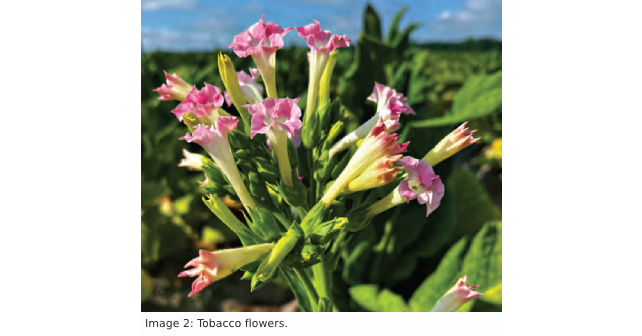
Many years ago, fresh out of my New York Toxicology Fellowship, I walked into an early September emergency department (ED) shift my first month as an attending in Eastern North Carolina to find six field workers lined up on hallway beds. They had just arrived—all suffering with severe nausea and vomiting, abdominal pain, and diarrhea. A quick examination revealed they were all relatively bradycardic, tremulous, and weak; they had pinpoint pupils and were soaked in sweat. I immediately ran to find the charge nurse and asked how we could report this cluster of possible nerve gas-exposed patients to the State, and if we should go on lockdown. He looked at me kindly, put a steadying hand on my shoulder, and said in his deep Southern accent, “Don’t worry, Dr. Hack, it’s just topping season, a little TLC and time, they’ll be fine.”
Explore This Issue
ACEP Now: Vol 43 – No 10 – October 2024History
Tobacco (Nicotiana tabacum) is a member of the Nicotiana genus—a relative to the nightshade family (potato, tomato, eggplant, belladonna)—that originated in the Americas. It was used for medical, social, and religious purposes by Native Americans for millennia, and introduced to Europeans in 1492 through Columbus’ exchanged gifts of fruit, food, and leaves of the tobacco plant during his “discovery.”
Later, Jean Nicot de Villemain (1530-1604) introduced tobacco to the French royal court, and his name became synonymous with the plant—Nicotiana tabacum and “nicotine.” The word “tobacco” is derived from the Caribbean word “tabaco” and Spanish word “tobah”—the device used to inhale smoke from the plant.5
While there are over 75 Nicotiana species, N. tabacum and N. rustica are the major cultivated species for human use. N. rustica, “Aztec” or “Indian” tobacco, is considered to be the original species (evidence of its use has been found from over 8,000 years ago) from which other tobaccos were cultivated. The first commercial crop of N. tabacum, grown in Jamestown, Va., in 1612 by the colonist John Rolfe (Pocahontas’ husband), spread first to eastern North Carolina and quickly became an agricultural foundation of this country. George Washington’s 1765 complaint letter to his London agent about the low prices he was getting for his tobacco harvest is evidence of the founding father’s involvement in the crop: “… it be … a little mortifying … [to] raise none but Sweetscented Tobacco, and … meet with such unprofitable returns.”13 Tobacco remains today one of the most economically important industrial crops worldwide—about six trillion cigarettes worldwide are smoked each year; 6.68 million metric tons of tobacco were produced in 2019.12
The Plant
N. tabacum is an herbaceous annual that has a thick, hairy stem and grows to about two to four feet in height. During its lifecycle, it produces clustered flowers (inflorescence) at its apex, which are tubular and have a corolla with five petals colored white, yellow, pink, or red. [image 2—tobacco flowers]. These flower bundles are physically removed from the plant (called “topping”) during a specific period of the growing season to stimulate the remaining green leaves to become bigger and promote root growth. (Nicotine is formed in the roots and sent to the leaves.) The leaves, the economically important part of the tobacco plant, grow alternately up the stem, are elliptical with a point, and grow to be 20 inches long and 10 inches wide. Dew on the leaves can contain up to nine percent nicotine.
Toxins
The plant’s major toxic alkaloid is nicotine, which binds to nicotinic acetylcholine receptors (nAChRs), is considered a psychostimulant, can produce analgesia and anxiolytic effects, and stimulates specific reward pathways in the brain at low doses. In larger doses, its effects include directly agonizing the medullary emetic chemoreceptor trigger zone, causing vomiting. Nicotine also stimulates sensory and parasympathetic nerves from the gastrointestinal (GI) tract, increasing fluid secretion and peristalsis and interacting with the nicotinic receptors in the central nervous system (CNS) and post-synaptic autonomic ganglia, causing CV fluctuations, weakness, and CNS excitement.
Tobacco also contains thousands of metabolites, which are being explored for both chemical and biologic uses—isoprenoids, flavonoids, cembranoid compounds volatiles, and recently acyclic hydroxygeranyllinalool diterpene glycosides have been characterized.4,11,14
Toxicity*: (*There is not enough room in this column to discuss the oncologic, pulmonary, hematologic, and other effects of tobacco or nicotine on humans. We will focus on one toxicity directly from the plant.)
Green Tobacco Sickness
Nicotine poisoning may occur from occupational exposures in workers who come in direct contact with the plant or its liquids, even through intact skin during crop maintenance—activities such as topping (cutting the flowers off), sucker removal (taking off the smaller side leaves), harvesting the leaves for processing, and working in the drying (curing) areas.
Several factors contribute to nicotine exposure and poisoning during this work—(1) Leaf harvesting usually occurs in late August or September when there is elevated ambient temperature and humidity, and frequent rain; (2) this causes sweating; (3) the heat discourages wearing protective clothing; and (4) physical labor increases dermal vascular dilation, which increases nicotine absorption by 45 percent; (5) water or dew on the tobacco leaves absorbs nicotine from the plant and can contain up to nine mg of nicotine per 100 mL; the average worker is exposed to approximately 600 mL of nicotine-containing dew per day (54 mg = 36 cigarettes) [cigarettes contain about 10 mg nicotine; 1.1-1.8 mg are absorbed through smoking]).2,8 Younger workers are especially vulnerable to green tobacco sickness because of their size and lack of tolerance and experience.2
Signs and Symptoms
- Onset varies between 15 minutes and 10 hours.
- The general symptoms are dizziness, generalized weakness, and prostration.
- GI symptoms include severe nausea, vomiting, and abdominal pain.
- CV symptoms: bradycardia/tachycardia and hypertension/hypotension
- Neurologic: headache, tremor, and seizure
- Somatic: muscular cramping, fasciculations, weakness, and respiratory muscle weakness
Treatment
- Primary goal is separating the patient from the exposure—removal of clothes that have been exposed or are wet, copious washing of the victim’s skin is critical to stop continued exposure.
- Anti-emetic and hydration as needed for fluid losses; benzodiazepines can be used for persistent vomiting and for comfort.
- Green tobacco sickness is usually a self-limiting condition—recovery occurs in one to three days.
- Prevention is paramount and consists of gloves, long sleeves, water-impermeable clothing, along with the ability and opportunity to wash skin with soap and water during work if contaminated with tobacco sap or dew.3
- Although not recommended, many tobacco workers self-treat by starting to smoke or chew tobacco to build a nicotine tolerance.
Tobacco Leaf Use Primer
Selected forms of tobacco—cigars, which are rolls of cured tobacco wrapped in tobacco leaf or paper that contain tobacco or tobacco extract, and cigarettes, which are uniform in size and usually contain less than one gram of tobacco each. U.S. cigarettes are made from different blends of unfermented tobaccos and wrapped with paper; chewing tobacco comes from loose leaves and is sold in various forms: pellets /“bits,” plugs (tobacco leaf pressed with a sweetener, usually licorice), twists (leaf tobacco rolled and twisted), and chaw—shredded and chewed leaf. These are placed in the mouth, usually between the cheek and lower lip, and may be chewed. Snuff is toasted and powdered for inhalation.10
Other Uses
- In various cultures, tobacco leaves (or their extracts) are used medicinally for bronchitis, tonsillitis, toothaches, wounds, sore throat, stomach infections, and arthritis.14
- Nicotine is used as a pesticide in many places in the world (in the United States, one product no longer available was Black Leaf 40).
- Blowing tobacco smoke up the rectum of a drowned person was a resuscitative technique widely used in the 1700s with variable success.1,6 This is no longer recommended.
 Dr. Hack is chief of the division of medical toxicology and vice chair for research at East Carolina University in Greenville, North Carolina.
Dr. Hack is chief of the division of medical toxicology and vice chair for research at East Carolina University in Greenville, North Carolina.
References
- Bamji A. Blowing smoke up your arse: drowning, resuscitation, and public health in eighteenth-century Venice. Bull Hist Med. 2020;94(1):29-63.
- Gehlbach SH, Williams WA, Perry LD, et al. Nicotine absorption by workers harvesting green tobacco. Lancet. 1975;1:478-480.
- Occupational Safety and Health Administration. Green Tobacco Sickness. Accessed September 15, 2024.
- Jassbi AR, Zare S, Asadollahi M, et al. Ecological roles and biological activities of specialized metabolites from the genus Nicotiana. Chem Rev. 2017;117(19):12227–12280.
- Koob GF, Arends MA, Le Moal M. Drugs, Addiction, and the Brain. Waltham, Mass.:Elsevier;2014.
- Lawrence G. Tobacco smoke enemas. Lancet. 2002;359(9315):1442.
- McBride JS, Altman DG, Klein M, et al. Green tobacco sickness. Tob Control. 1998;7(3):294-298.
- McKnight RH, Spiller HA. Green Tobacco Sickness in Children and Adolescents. Public Health Rep. 2005;120(6):602-605.
- Mishra S, Mishra MB. Tobacco: its historical, cultural, oral, and periodontal health association. J Int Soc Prev Community Dent. 2013;3(1):12-18.
- National Cancer Institute. NCI Dictionary of Cancer Terms: chewing tobacco [ND]. Accessed September 15, 2024.
- Popova V, Ivanova T, Stoyanova A, et al. GC-MS composition and olfactory profile of concretes from the flowers of four Nicotiana species. Molecules. 2020;25(11):2617.
- Shahbandeh M. Statista. Global tobacco production 1990-2022. Published February 13, 2024. Accessed September 15, 2024.
- National Archives. Founders Online: From George Washington to Robert Cary and Company, 20 September. Published September 20, 1765. Accessed September 15, 2024.
- Zou X, Bk A, Abu-Izneid T, et al. Current advances of functional phytochemicals in Nicotiana plant and related potential value of tobacco processing waste: a review. Biomed Pharmacother. 2021;143:112191.
Click here to see the original question.
Pages: 1 2 3 4 | Multi-Page





No Responses to “Toxicology Answer: The Pretty and Toxic Tobacco”